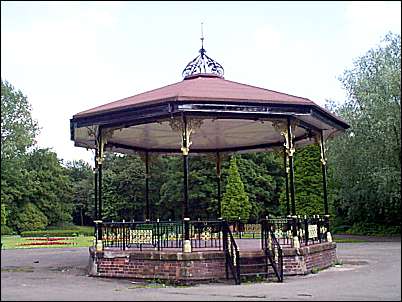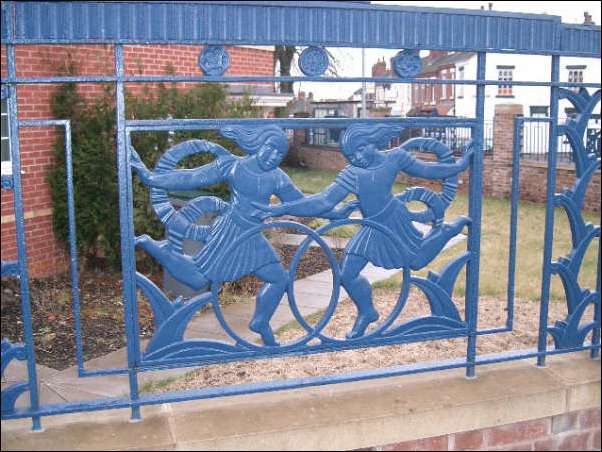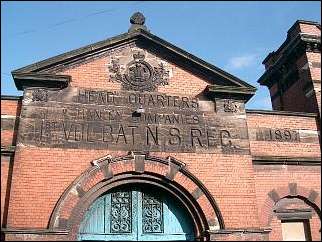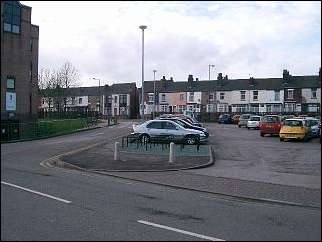|
The author can now take up the narrative,
based on personal knowledge and recollections. Although this is intended
to be about St Jude's and not one person's reminiscences, it is
inevitable that a certain amount of nostalgia will intrude. For that I
crave indulgence but offer no apology.
The late 1930's saw preparations for war
although to a small child, life remained unchanged. Holidays to the
seaside, visits to Hanley Park and shopping in a large perambulator. An
early memory involved going with the ladies of the family to the Jubilee
Hall in Stoke Town Hall, to be issued with our new Ration Books. An
air-raid shelter in the back yard, siren suits and Air Raid sirens,
visits to the shelter shared with neighbours during the Black-Out, with
the sounds of aircraft overhead and the All-Clear siren afterwards.
Seaford Street had a large communal shelter
and a static water tank built at the side of the street. These tanks
were a fatal attraction for some children as they were about six feet
deep with no means of escape once in the water. Dire warnings were
issued and the tanks covered with wire netting in an attempt to stop
trespass. This measure was not always successful. Gas-lit streets were
dark during the Black-Out, which was enforced by street wardens, and
everyone not "called up" for the armed forces seemed to be involved in
the war effort.
Home Guard, Air Rid Precautions (ARP),
Civil Defence, Womens' Voluntary Service (WVS), Auxiliary Fire Service (AFS)
and Ambulance Drivers were all neighbours doing their bit. Even school
children were encouraged to play their part. At Cauldon Road School,
books and other comforts for the troops were collected and National
Savings was a patriotic duty. Milk, orange juice, cod liver oil and
drinking chocolate powder were issued as dietary supplements.
The Territorials or "Terriers" as they
were affectionately known, were immediately mobilised along with
reservists from the other Services. Initially men between 18 and 26 were
called up for armed service, but gradually the age was increased to
include older and older men. Men in certain specified "reserved
occupations" were barred from military service; mining, heavy industry
and transport were included with others. Women too were directed into
war jobs, some actually into the womens' sections of the armed forces,
the WRNS (Wrens), The ATS and the WAAFS, while the Womens' Land Army,
munitions and certain industrial work also needed labour. Some men were
in the frustrating position of having been too young for the First War
and were now too old or otherwise disqualified for the Second War, and
took the only alternatives open to them. Only the very old, the very
young or mothers with families were seen in the streets during the
daytime, whilst at night the remaining men after a day's work took on
their auxiliary roles. King George VI paid tribute to them at the end of
the War.
Stoke Railway Station was a hive of
activity, and was always thronged with men and women in uniform. A small
boy with a soap-box cart, if he positioned himself at the top end of
Victoria Road, or along Leek Road could always earn a few coins by
transporting soldiers' kit bags for the final half mile to the station.
It also worked in reverse when the men came on leave. The fare was by
negotiation depending on the distance involved, but it was touching how
generous they were, and how grateful. The Red Cross coffee stalls and
the WVS were always on hand with refreshments.
Winters seemed long and
harsh, while summers seemed endless and hot and we spent our days in
Hanley Park without let or hindrance, always of course keeping an eye
out for the "Parkies" who
despite their advancing years and sometimes disabilities, could send
a gang of small boys flying for cover. Band concerts were frequent
events in the Park at week-ends, the tell-tale sign being a canvas
coin-collector at the gate, reminiscent of a Field Wash-Stand, manned
by a Bandsman.

The bandstand in Hanley
Park
Membership of the Choir and Sunday School at St Jude's
was as natural as breathing, and took up all Sunday, with a choir
practice in the week. Sometimes a funeral or a wedding on Saturday could
earn a halfcrown. Too late for the morning cinemas in Stoke or Hanley,
but one could always catch the afternoon show at the Princes in Wharf
Street, between the canal and St Peter's Church. There were patriotic
collections of all things aluminium to build Spitfires, and iron garden
railings were compulsorily cut down and carted away for the War Effort.
The stumps of these railings could be seen for years afterwards; even
today if you look carefully at the forecourt walls of some older
houses, they are still in evidence.
Legend has it
that despite good intentions,
much of the accumulated metal was never used for its intended purpose.
For iron railings to be spared from this fate, they had to be of special
architectural or historical significance, and another legend has it that
the newly erected ornamental railings at the Orthopaedic Hospital in Hartshill ( known as "the Cripples"), which depicted children engaged in
all kinds of healthy activities became a contentious issue. Apparently
the Hospital Board's architect was also appointed to oversee the
activities of the Metal Salvage Board, and engaged in correspondence
with himself, on one hand as the Appellant, and one the other hand as
the Confiscating Authority. The Hospital won and the railings are still
to be seen in Hartshill.

ornamental railings
from the Orthopaedic Hospital in Hartshill
During the war years, even children were
surprisingly aware of the progress of the conflict, Newspaper headlines,
grave news broadcasts on the BBC, newsreels at the cinema with aerial
photographs of bombing and sea landings; ending of course with the
sports reports; Brylcreemed footballers wearing incredibly baggy shorts
and iron-hard, studded boots as we boys could confirm, being equipped
with smaller versions for our desperate games in Hanley Park. The Drill
Hall at the top end of Victoria Road, housed an anti-aircraft battery of
real soldiers, and we could see them inside at their drills and see
their neatly made-up beds and equipment.

Shelton Drill Hall - top
of Victoria Road (now College Road)
In the last remaining field this side of
the River Trent, known as Poxon's Field not far below the Terrace Inn,
was a stock of all manner of concrete defence artefacts, road materials
and cylindrical tank obstacles. German prisoners of war worked in the
field, guarded by soldiers with rifles and fixed bayonets - how closer
to the war could you be? The soldiers and prisoners were quite affable,
and a barter system developed whereby chocolate, cigarettes, soap,
badges and other mutually attractive items were exchanged.

Location of
Poxon's Field
now part of Staffordshire University Car Park
the terrace houses in the background are on Leek Road
Every tradesman who did the rounds of our
streets had a horse-drawn cart. The milkman, the baker, the coal man,
the green grocer, the fish monger, the dustbin and paper salvage
collectors and the rag and bone man, As I recall there was only one car
in our street, owned and driven by our next door neighbour Bob Machin
who ran a saw mill near Limekiln Bank at Bucknall. I sometimes begged a
ride as far as Joiner's Square during the lunch hour, and would then
scamper back to Cauldon Road School in time for the afternoon session.
Such was the novelty of motor cars! The smell of leather, oil and petrol
lingers in the memory to this day.
Then one day it was all over. Bells rang
out, there were flags and bunting everywhere, and impromptu parties for
the children in every street. Trestle tables, urns and food
materialised as if by magic. The party food would be considered pathetic
by today's standards, but what an occasion!
A Victory Parade marched up Stoke Road to
Hanley, and then down again. An endless column of marching men and women
from all the regular and auxiliary forces and organisations,
interspersed with vehicles of every description, even a tracked Bren
gun-Carrier. There was also Beating the Retreat by an Army Band or Corps
of Drums, up and down the Esplanade below the Pavilion in Hanley Park.
The transition from war to peace had little
effect on children, although for some it meant meeting their fathers
again after years of absence, for others it meant having no father at
all. Few people had mourning clothes, and loss was expressed by a black
armband or a black patch sewn onto the sleeve. Men with wooden legs were
a common sight, as were pinned-up empty sleeves. In the years of
austerity after the war, we can have no idea of the effect constant
shortages and continued rationing had on our grown-ups. Clothes were
handed down worn and patched, socks were darned (who darns today?),
shoes or boots were soled and heeled with thick leather and then studded
and steel-tipped for longer wear. We must have sounded like an army
coming out of school. Our blue belted raincoats went by the generic name
of "Burberries", but they were hardly fashion items. And so we moved on
from the 1940's.
The built environment of St Judes had
changed little, although gas street lighting gave way to electricity and
householders were being encouraged to buy their homes and to obtain
improvement grants from the Corporation, as the City Council was always
called. Sculleries, glory-holes and outside W.C.s were "knocked through"
to provide indoor plumbing and bathrooms, and some people went on the
lists for the new Council Houses which were springing up.
We bought our house for £250 and I
regularly had to take the new monthly mortgage payment to the offices of
the Stoke-on-Trent Permanent Building Society in Liverpool Road, Stoke.
Two elderly, balding, bespectacled gentlemen sat at a table under a
window at the far end of a long, unlit room, to be approached noisily
across bare floor boards. It was positively Dickensian. After handing
over the payment book, the transaction went something like this:-
1st Old Gent. "Alcock, Account
6774. Amount Two pounds three shillings and ninepence"
2nd Old Gent. "Hallcock,
sixtyseven-seventyfour, two-three-nine"
No 1 would take the cash which he would
carefully count into wooden bowls watched by No 2 who would enter
the the details into a large ledger with a straight, wooden, steel-nibbed
pen (just like we used at school). No 1 would enter the details into
our account book with a fountain pen, carefully blot it and return
it saying:- "Thank you sonny. Good morning" "Good
morning" added No 2.
Back across the floorboards and into the
light of Liverpool Road. With the morbid curiosity of a small boy, I
always hoped I would see Mr Albert Lownds the butcher, who had a shop
where the Fowlea Brook ran under Liverpool road. Mr Lownds had an
enormous growth on his face, literally the size of a football and he
used to visit our next door neighbour Jack Machin. They drank draught
beer from Feazy's and sang old music hall ballads. I often wondered
whether his cheek was hollow and could hold lots of beer. One day Mr
Lownds appeared with a bandage round his head but no lump. He died soon
afterwards.
Frequently cattle and sheep were driven up
Victoria Road (now College Road) from the railway station to the
abattoir at Mayer's Field. When I say driven I do not mean in motor
vehicles, I mean on foot, in large herds which escaped down the side
streets and caused no end of a spectacle. Similarly when the circus came
to town, the animals arrived by train and were paraded along Victoria
Road to their temporary home at the top of Hanley Park.
  
next: boyhood - continued
previous: St. Jude's 1900-1939
|
![]()
![]()
![]()